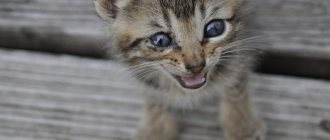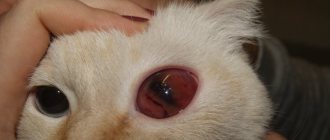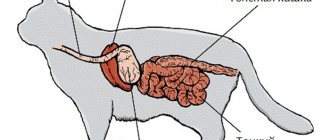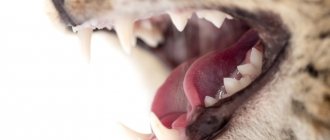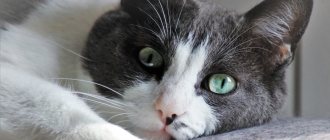4400Pavel
Cats, like other animals, can have gastrointestinal inflammation. One of the manifestations of the disease is colitis. The disease does not reveal itself for a long time, being asymptomatic until it begins to become chronic. Therefore, it is very important to promptly identify the symptoms and treat colitis in cats.
For various reasons, the mucous membrane of the colon becomes inflamed in the cat’s body. Due to colitis, fluid is no longer absorbed in the intestines, which leads to digestive disorders.
© shutterstock
Most often, cats develop diarrhea or constipation. The owners do not immediately attach importance to such manifestations. And if you don’t immediately contact a veterinarian for a diagnosis and start immediate treatment, the disease will not go away on its own. It will entail consequences and the worst thing it can lead to is the death of the sick animal.
Causes
The main reason that causes colitis in cats is poor nutrition. Low-quality, rotten, low-quality products, food from “your own table” do not contribute to the improvement of the gastrointestinal tract. Poisonous toxins, which are a product of food breakdown, irritate the mucous membranes.
This creates a favorable environment for the development and activity of pathogenic bacteria. The large intestine reacts to this phenomenon with increased peristalsis, diarrhea, vomiting and other symptoms characteristic of colitis.
Other factors that provoke the development of the disease include:
- contaminated or raw tap water;
- hot or cold food;
- consumption of products unnatural for animals (sweets, pasta, etc.);
- helminth infection;
- pathologies of infectious and non-infectious nature;
- dysbacteriosis;
- allergy;
- metabolic disease;
- accidentally swallowed foreign objects, including fur, stuck in the colon;
- eaten rodents;
- intestinal injuries (tubular bones consumed as food may well cause mechanical damage to the gastrointestinal tract).
Finally, colitis often develops against the background of stress associated with a change of place of residence, the appearance of another pet in the house, etc.
How does this disease manifest itself?
The main complaint that manifests itself first and with which the owners turn to the veterinarian is colonic diarrhea.
Owners will be struck by an undecorated stool in a tray, which has an unusually foul odor for a pet’s feces. If you look closely, you will see an uncharacteristically large amount of mucus in the stool and traces of blood.
If the cat is affectionate and is often close to the owner, the owner of the animal may hear a strange rumbling in the cat’s stomach. When you try to touch the belly of your favorite animal, it will be swollen, dense, and painful.
Reference!
Despite all the horrors of the disease, the cat eats as usual.
If the purring family member is not treated in time, a vicious circle occurs.
Constant diarrhea leads to a lack of fluid, vitamins and fats in the cat's body. Since the rest of the digestive system is working well, the cat tries to make up for the deficiency.
She eats larger portions than usual. But in the intestines, absorption is still impaired. An increased amount of food causes more and more diarrhea, and more and more diarrhea, in turn, causes an increase in food. This is how a vicious pathological circle is formed with colitis in cats.
When the disease is left untreated for a long time, the cat begins to rapidly lose weight. This condition can lead to complete exhaustion and even death of the animal. Therefore, it is better to start treatment as quickly as possible, so that the only problem the cat suffers from is diarrhea.
Reference!
The cat may also be bothered by vomiting. This is a symptom uncharacteristic of colitis, but occurs periodically with this disease.
Symptoms
Acute colitis is characterized by a clear clinical picture. The first symptoms may appear within a couple of hours after the action of the provoking factor. The cat does not show activity, hides from the owner, does not respond to calls, and lies down most of the time. There is no appetite, vomiting may occur.
As the disease progresses, the animal's temperature rises, convulsions appear, and the mucous membranes turn blue. Characteristic symptoms are a dirty white coating on the tongue, a rotten smell from the mouth.
The stool is liquid, glassy, mixed with blood and pus. Defecation is frequent, and you can see that the sphincter is in a relaxed state, and the posterior rectum is gaping.
The cat's belly is inflated like a drum. When you press on it, even from a distance, bubbling, seething sounds can be heard. The animal experiences severe pain upon examination.
The chronic stage of colitis is practically asymptomatic. Only stool that smells bad and has a non-specific color of stool can cause anxiety.
How to prevent the occurrence of colitis?
As you know, it is better to prevent a disease than to treat it later. This statement also applies to colitis. The following simple rules will help prevent the disease:
- The cat's nutrition must be correct and balanced. It is best if it is premium industrial food (Royal Canin, Purina Pro Plan and others);
- The diet should have enough fiber;
- You should not feed your cat lard. It's better to give her turkey meat;
- There is no need to give your cat antibiotics every time the animal sneezes;
- It is necessary to conduct examinations with a veterinarian once a year for preventive purposes. For older cats (over 12 years old) – once every 6 months.
Diagnostic methods
Diagnosis of colitis consists of differentiating it from other diseases of the gastrointestinal tract with similar symptoms. To make a diagnosis, the veterinarian, in addition to a visual examination and medical history, needs to conduct a number of diagnostic studies:
- scatological analysis of stool;
- colonoscopy;
- biopsy;
- general and clinical blood tests;
- barium enema followed by an x-ray of the colon.
After determining the diagnosis, the specialist prescribes appropriate treatment.
How is the disease diagnosed?
It is very important for a caring owner of a domestic cat that a diagnosis is carried out and the correct diagnosis is made. Veterinarians resort to several methods to most accurately diagnose the disease.
First of all, you need to conduct an ultrasound examination of the abdominal cavity. An x-ray will then be required to rule out the presence of a foreign body in the cat’s body.
© shutterstock
Then an endoscopy is performed and the pancreas is examined. A prerequisite will be the donation of blood, feces and urine for analysis.
In rare cases, but still a biopsy is performed. This procedure is performed under general anesthesia, as a piece of tissue will be plucked from the colon for examination.
Treatment, prognosis
With timely treatment, the prognosis is favorable. The course of therapy lasts 5-7 days. It consists of three stages: restoring water-salt balance, stabilizing stool, and relieving symptoms of intoxication.
To remove toxins, adsorbents are prescribed - activated carbon, white clay, Smecta. Using an enema, the intestines are washed out or a drug based on sodium sulfate is given (one time).
To restore water balance, rehydration therapy is necessary by orally administering Ringer's solution (alternatively, a weak solution of table salt) or injecting saline with glucose.
In case of bacterial infection, the use of antibiotics (Tylosin) and antiprotozoal drugs (Metronidazole, Furazolidone) is indicated.
For the allergic nature of colitis, corticosteroids (Prednisolone) are prescribed, and for the chronic form, anti-inflammatory drugs (Azathioprine, Sulfasalazine). To restore normal intestinal microflora, probiotics are needed (Pro-Kolin, Lactobifid, Lactoferon).
Types of colitis
Colitis can be ulcerative (chronic form), viral or bacterial. Toxic, if the cat has eaten something inedible, and ischemic. Pseudomembranous is a dangerous form of colitis with inevitable complications.
© shutterstock
The disease can affect the entire large intestine. Or there will be foci of inflammation in the rectum or cecum.
What to do at home
The owner must follow the veterinarian's instructions. Self-medication can aggravate the situation and worsen the cat's condition. You can use decoctions of medicinal herbs (chamomile, plantain), which have antiseptic and anti-inflammatory properties. However, they should not completely replace traditional treatment.
Great importance is paid to the nutrition of the animal. Your pet should receive balanced, high-quality food that promotes intestinal restoration (Sensitive, Royal Canine GastroIntestinal).
How to treat a cat with colitis?
The main principles of colitis treatment:
- It is necessary to start treatment as early as possible;
- Your cat's diet should contain less fat and more fiber;
- Premium hypoallergenic food is well suited for cat nutrition;
- Depending on the type of pathogen, antibacterial, antiviral, antiparasitic and antifungal drugs are prescribed. Sometimes a combination of these is used;
- Antidiarrheal drugs are used to relieve diarrhea;
- For autoimmune inflammation, immunosuppressants are prescribed in combination with antibiotics and antiparasitics.
Important!
You should not try to treat your cat yourself. If symptoms appear, you should immediately seek medical help from a veterinary clinic!
Spastic colitis in cats (irritable bowel syndrome)
Home / Diseases of cats / Spastic colitis in cats (irritable bowel syndrome)
The most common signs of colitis and proctitis in cats is a bowel movement disorder, which is manifested by chronic diarrhea, often mixed with blood. Therefore, diarrhea is one of the main reasons why cat owners contact a veterinarian. Chronic diarrhea represents a difficult diagnostic problem. Most likely, this is due to the wide variety of diseases in the range of differential diagnosis. The main causes of such diseases are endoparasites, enteropathies, intestinal dysbiosis, idiopathic intestinal diseases, intestinal lymphomas, bacteria, protozoan invasion, allergic factors, etc. Defecation, compared to small intestinal diarrhea, can be frequent, in small portions, stools are unformed, liquid.
In such diseases, anamnesis is extremely important. Owners of their pets are not always inclined to tell plausible stories from the lives of their pets, or they lose sight of past illnesses. Therefore, it remains important to obtain a complete nutritional history and a systematic approach for the most accurate diagnosis. Endoparasitic pathologies are to some extent easier to diagnose and treat, but they should not be excluded. Regardless of the results of the study, a broad-spectrum anthelmintic drug is prescribed.
Clinical case.
Clinical signs of diarrhea that appears periodically. An admixture of blood and mucus appears in the stool, which, in principle, alarms the owners. This might not have happened before. Sometimes defecation is accompanied by cramping pain in the lower abdomen. Pain also appeared during the act of defecation, flatulence was observed, and sometimes vomiting occurred. Hairballs can also be found in the vomit, sometimes in quite large quantities. In this case, the general condition and behavior of the animal changes only during the period of diarrhea. The animal becomes apathetic, lethargic, and sleeps most of the day. A physical examination does not always reveal abnormalities, only minor discomfort upon deep palpation.
For additional diagnostics, ultrasound diagnostics of the intestines and a clinical blood test were prescribed. Clinical blood tests are often within normal limits. According to the results of ultrasound, it is important to exclude foreign bodies and other space-occupying formations, the contents in the colon are predominantly weakly echo-dense (pasty) with gases, visible areas of the wall in the colon can be enlarged while maintaining the differentiation of the layers, in the cecum the wall is thickened, l / without features.
In the first days, treatment is carried out on an outpatient basis, then owners can perform many manipulations at home and come to the appointment at the time prescribed by the doctor to correct the treatment regimen. A treatment regimen should be discussed with the owners, the possibility of a protracted course of the disease and the need to exclude all stress factors, and strict adherence to the diet should be informed.
Drug therapy:
* Drugs that regulate intestinal motility - loperamide 0.1 mg/kg orally 3 times a day for the first 1-2 days
Prevention
We have already found out what colitis is in cats. The symptoms and treatment have been discussed in detail above. Now let's talk about preventive measures. These include the following:
- Lack of stress in the animal's life.
- Proper nutrition. Use only high quality feed. If you plan to feed “natural”, then create a balanced diet. Add vegetables and offal to it. Don't change what I'm used to. A sudden change in diet leads to various intestinal disorders. The animal must have regular access to water.
- It is imperative that the animal undergo timely deworming and vaccination.
- Don't forget about a routine check-up with your veterinarian.
Here's how to prevent colitis in cats. The above recommendations will help your pet stay healthy and strong. This way you can reduce the chances of such a disease occurring.
Now you know what colitis is in cats. Symptoms and treatment of this disease are two topics that we discussed in detail in our article. We also provided useful recommendations for the prevention of this disease in cats.
Animals have a similar digestive system structure to humans, and therefore their digestive system diseases are identical to ours. One of the most common pathologies of the gastrointestinal tract is colitis.
What is inflammatory bowel disease
Intestinal inflammation begins with swelling of the villous epithelium that covers the mucous membrane. The secretory activity of the glands and motility changes. This in turn leads to a change in pH acidity and contributes to the transition of opportunistic microflora to pathogenic.
Violation of the composition of microorganisms leads to dysbacteriosis. The intestinal contents stop being absorbed and begin to decompose with the help of already pathogenic microflora. Toxic metabolic products (phenol indole) are absorbed into the blood, which leads to intoxication of the body.
Chronic form of inflammation
If acute inflammation is “treated”, the symptoms are eliminated, but the cause is not eliminated, the disease becomes chronic. In this case, the stage of remission alternates with exacerbation, and the clinical picture repeats from time to time.
Chronic enteritis and enterocolitis are recorded in:
- old animals;
- cats after suffering viral diseases;
- animals with low immunity;
- for diseases of the liver, heart and kidneys;
- with regular feeding disorders.
The acute form of enteritis is easily treatable (if it is not a viral pathology or poisoning). The owner calms down and the animal is supposedly healthy. However, you should carefully monitor the cat’s condition so as not to miss a relapse.
